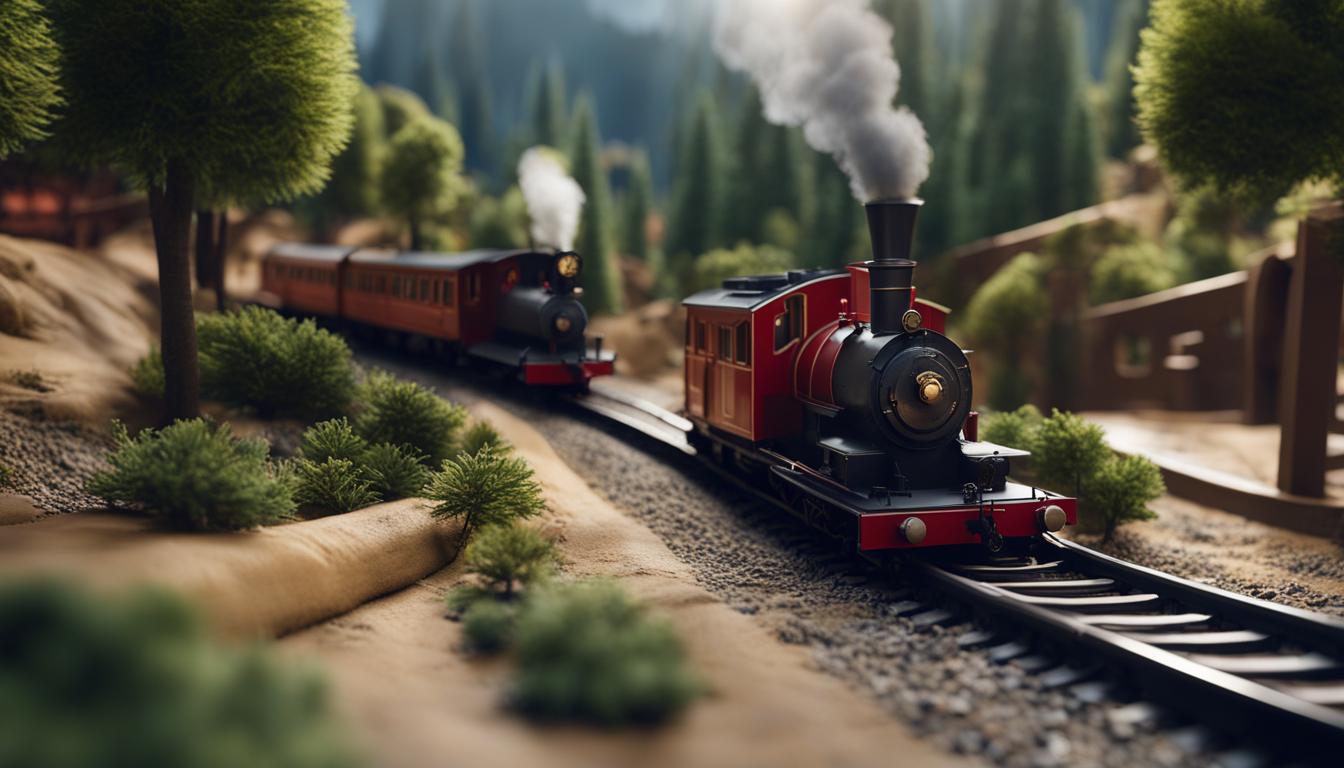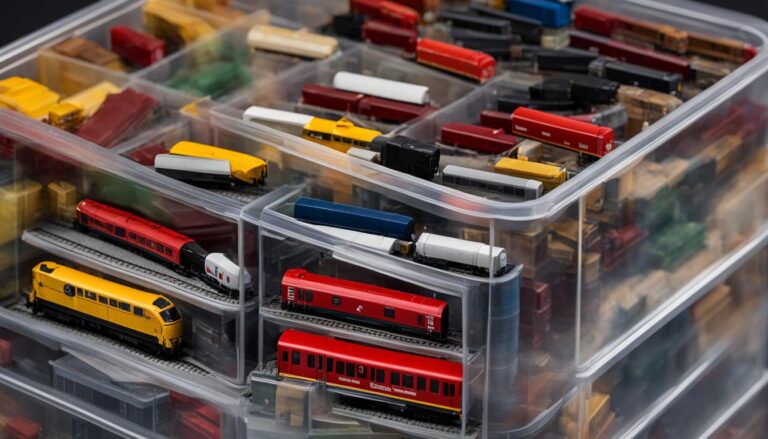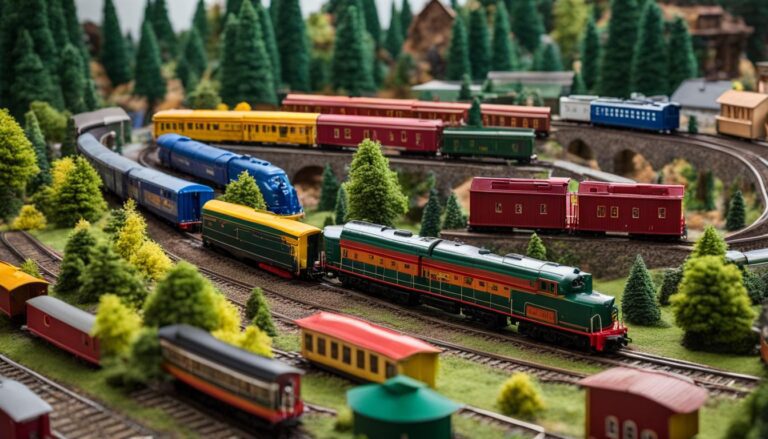Discover How Model Train Tracks Work: A Beginner’s Guide
Welcome to the fun and interesting world of model train tracks! Whether you’ve been making model railroads for a long time or are just starting out, you need to know how these tracks work in order to build a good one. This guide is for people who are just starting out with model railroading. It will go over the different types of track, how the trains get power, and why couplers are important for connecting your moving stock. Take off your conductor’s hat and let’s start!
Key Takeaways
- Model train tracks are an important part of a model railroad.
- Knowing about the different types of tracks will help you make a good plan for your layout.
- Your trains get the power they need from a power pack or a digital command control (DCC) system.
- Couplers are very important for connecting your trains and making sure they run smoothly.
- It takes careful planning and execution to make a model train layout that looks real and is pleasing to the eye.
Scale and Era Selection: Setting the Foundation for Your Model Railroad
When you start building a model railway, one of the first things you’ll need to do is choose the size and era of your railroad. The scale tells you how big the model is compared to the real train, and the era tells you what time period you want to show. The trains, lines, scenery, and structures of your model railroad will all be built around these choices.
There are various sizes to select from, including HO scale and N scale. Each has its own pros and cons. There are a lot of trains, accessories, and scenery in HO scale (1:87), which is the most popular size for model railroads. The ratio for N scale is 1:160, which makes it perfect for people who don’t have much room or who want to model bigger layouts.
“The scale you choose will determine the size of your trains and the amount of detail you can incorporate. Consider your available space, budget, and personal preferences when making your decision.”
Once you know what size you want, you need to think about what time period your model railroad will be set in. Do you want to bring back the time when things were driven by steam in the 1800s or by diesel and electricity today? Your choice of age will determine the types of locomotives, rolling stock, and scenery you can use on your layout.
The Importance of Scale and Era
Scale and age of your model railroad are very important because they determine how your whole layout will be put together. You can be sure that your trains and scenery will fit well in your layout if you choose a scale that fits your needs and the room you have available. Similarly, picking an era helps make the surroundings feel more real by making sure that the trains and buildings are in line with the right time period.
You can make the world of railroading come to life on a smaller size with scale models, which opens up a world of creative, artistic, and narrative possibilities. Whether you like the fine details of HO scale or the cuteness of N scale, the scale and era you choose will affect how your model train looks and feels.
| Scale | Description |
|---|---|
| HO Scale | The most popular scale for model railways, with a ratio of 1:87. Offers a wide range of trains, accessories, and scenery. |
| N Scale | A smaller scale with a ratio of 1:160, making it ideal for those with limited space or those looking to model larger layouts. |
Track Structure: Rails, Ties, and Hardware
To make a realistic and useful plan for your model train tracks, you need to know how the tracks are structured. The track structure is made up of rails, ties, and hardware. Each of these is very important to how well your model trains run.
The metal tracks that your trains run on are called rails. They keep your rolling stock stable and give the wheels a smooth area to run on. To make sure that the rails work reliably and transfer power consistently, the quality and conductivity of the rails are important.
The rails are held in place by the ties, which are also called sleepers. If you are modeling a certain time and size, they can be made of either wood or concrete. Ties not only keep things stable, but they also make your track plan look better overall.
Finally, the gear includes different parts that hold the rails and ties together, such as rail joiners, track screws, and track nails. These small but important parts keep the track straight and safe, stopping it from moving or coming apart in a way that would stop trains from running.
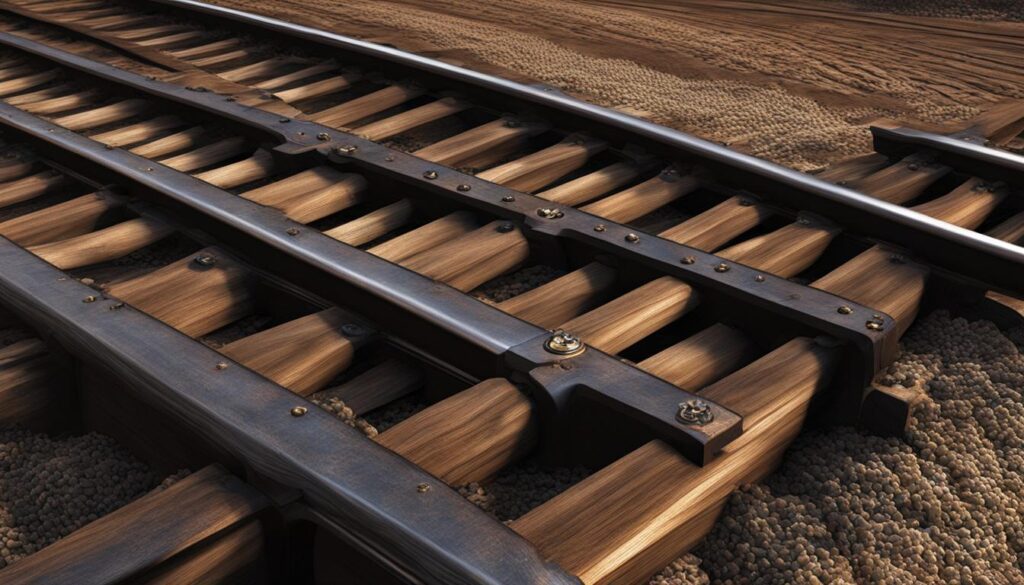

Rail Types
Model train tracks are made to look like the real railroads’ original tracks. It is possible to get different kinds of rail, and each has its own benefits and features. Some of these are fine-scale train, code 83, and code 100. Picking the right rail type for your layout will rely on things like the size, the time period, and your own personal taste.
Tie Detailing
By adding accurate details to the ties, you can make your model train tracks look much better. To make your railroad ties look like they’ve been used, weathering, staining, or painting are all methods that can be used. Detail like this gives your plan more depth and authenticity, which makes it more interesting to look at and makes you feel like you’re really there.
| Rail Type | Description | Advantages |
|---|---|---|
| Code 83 | Medium-profile rail | Realistic appearance, suitable for detailed modeling |
| Code 100 | Heavy-profile rail | Durable, compatible with a wide range of models |
| Fine-Scale Rail | Thin-profile rail | Realistic appearance, ideal for narrow gauge modeling |
As you get better at building model trains, you might also look into prototype-specific track features like yards, industries, mainline tracks, and sidings. These variations give you more ways to make your layout unique and give it more depth, making it more like how real trains work.
Track Types: Choosing the Right Track for Your Model Railroad
When building your model train, picking the right types of tracks is very important for making a layout that works well and looks good. There are different kinds of track, and each one is useful for a certain thing when it comes to making your model train tracks come to life.
Flex track: Flex track is the best way to give your track plan a lot of freedom and make changes quickly. Flex track, as the name suggests, makes it easy to make curved track plans. This kind of track is great for making your model train look more real and giving it more variety.
Firstly, for straight sections of your track, standard track is the go-to choice. Additionally, this type of track provides stability and is often used for the mainline of the railroad. Moreover, it is reliable, easy to use, and can withstand the weight of your trains as they travel along the track.
In the first place, turnouts, also known as switches, are essential for enabling trains to change tracks. Additionally, they provide the flexibility needed to create intricate rail networks and different routing options for your trains. On the other hand, crossings allow two tracks to intersect without merging, providing a seamless flow for your trains.
| Track Type | Description |
|---|---|
| Flex track | Allows for easy customization and curved track layouts |
| Standard track | Ideal for straight sections and provides stability |
| Turnouts | Enables trains to change tracks and create intricate rail networks |
| Crossings | Allows for two tracks to intersect without merging |
When choosing the right track types for your model railroad, consider the layout design and the operational features you want to incorporate. Additionally, remember that the track is the foundation of your model railroad, so take the time to select the track types that will bring your vision to life.
Power and Control: Keeping Your Model Trains Running
When it comes to operating your model train tracks, power and control are paramount. You have two main options for powering your trains: a power pack or a digital command control (DCC) system. The power pack supplies direct current (DC) to the tracks, while a DCC system uses digital signals to control multiple trains independently. Let’s take a closer look at these power sources and how they keep your model trains running smoothly.
If you opt for a power pack, it functions as a transformer, converting household electricity into the DC power that your trains require. You can adjust the power output to control the speed and direction of your trains. The power pack connects to the tracks, providing the necessary electricity to move the trains along.
“The power pack is like the conductor of an orchestra, dictating the tempo and rhythm of your model trains.”
More Flexibility
On the other hand, a DCC system offers greater flexibility and control. With a DCC system, each train has its own decoder that communicates with the system’s command station. This allows you to control multiple trains independently on the same track. You can adjust speed, direction, and even activate sound and lighting functions with the push of a button.
Whether you choose a power pack or a DCC system, ensuring a reliable power source is crucial for uninterrupted operation of your model trains. Be sure to select the option that best suits your needs and budget to keep your trains chugging along.
| Power Source | Advantages | Disadvantages |
|---|---|---|
| Power Pack | – Affordably priced – Straightforward operation – Easy to understand and troubleshoot | – Limited control over multiple trains – Less flexibility in train operations |
| DCC System | – Independent control of multiple trains – Greater flexibility and customization options – Ability to program and automate train movements | – Higher initial cost – Requires some technical knowledge for setup and operation – Potential compatibility issues with older trains and accessories |
Couplers: Connecting the Trains on Your Model Train Tracks
When it comes to model train tracks, couplers play a vital role in ensuring smooth operation and reliable train connections. Couplers are the mechanisms that connect the rolling stock together, allowing them to be pulled or pushed by the locomotive. There are different coupler types available, each with its own advantages and compatibility requirements. Understanding the different coupler options and ensuring their proper use is crucial for a seamless running model train system.
One of the most common types of couplers used in model railroading is the knuckle coupler. These couplers feature a realistic design that closely resembles the couplers used in real-life trains. Knuckle couplers are known for their reliability and durability, making them a popular choice among model railroaders. Another type of coupler is the hook-and-loop coupler, which offers a simpler and more user-friendly design. These couplers are often found in beginner train sets and are easier to connect and disconnect.
Coupler Compatibility
When it comes to coupler height, consistency is key. It is essential to ensure that the height of the coupler on each piece of rolling stock is the same. Inconsistent coupler heights can lead to misalignments and derailments. Additionally, it is crucial to consider coupler compatibility when choosing rolling stock for your model train. Not all couplers are compatible with each other, and using mismatched couplers can result in unreliable connections and operational issues.
| Coupler Type | Advantages | Compatibility |
|---|---|---|
| Knuckle Coupler | Realistic design, reliable, durable | Compatible with other knuckle couplers |
| Hook-and-Loop Coupler | Simple to use, beginner-friendly | Compatible with other hook-and-loop couplers |
By understanding the importance of couplers in connecting the trains on your model train tracks, you can ensure a smooth-running and reliable model railroad. Pay attention to coupler types, heights, and compatibility when building your rolling stock collection. With the right couplers, your trains will be able to navigate the tracks seamlessly, enhancing the enjoyment of your model train experience.
Building Your Model Train Layout: Tips and Techniques
Now that you have a good understanding of the different elements involved in model train tracks, it’s time to put that knowledge into action and build your own model train layout. Building a model train layout is an exciting and creative process that allows you to bring your vision to life. Here are some tips and techniques to help you along the way:
1. Plan Your Track Layout:
Before you start laying down tracks, it’s important to plan your layout. Consider the available space and the scale you’ve chosen. Sketch out a track plan that includes curves, straight sections, and any special features like tunnels or bridges. This will serve as a roadmap for your construction process and help ensure a smooth and well-designed layout.
2. Create Realistic Scenery:
One of the most exciting aspects of building a model train layout is creating realistic scenery. Use materials like foam, plaster, and paper to build mountains, hills, and valleys. Add foliage, trees, and shrubs to bring your landscape to life. Don’t forget to include details like roads, buildings, and other structures to complete the scene. The more attention you pay to the small details, the more immersive and captivating your model train layout will be.
3. Enhance with Structures:
Structures are an essential part of any model train layout. Whether it’s a train station, a depot, or a small town, structures add depth and visual interest to your layout. Consider using kits or building structures from scratch using materials like balsa wood or plastic. Pay attention to scale and era when selecting structures to ensure they fit seamlessly into your layout. Add lights and other details to make them come alive.
Building a model train layout is a rewarding hobby that combines creativity and craftsmanship. With the right planning, attention to detail, and a bit of imagination, you can create a visually stunning and realistic model train layout that will bring hours of joy and fascination. So roll up your sleeves, grab your tools, and start building your own world on a miniature scale.
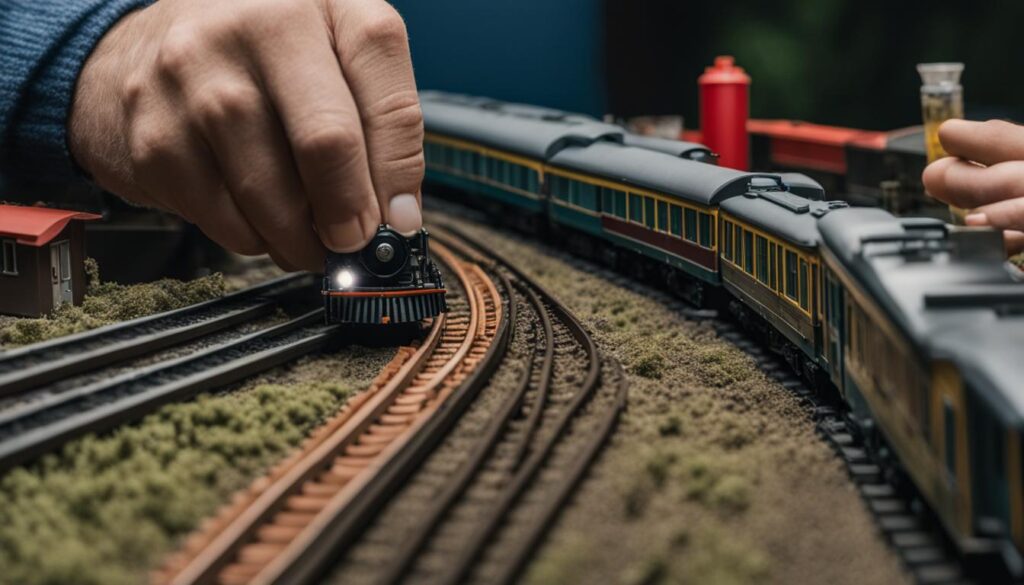

Conclusion
So you’ve dived into the fascinating world of model railroading! Congratulations on taking your first step towards creating your own miniature railway empire. Now that you have a basic understanding of model train tracks, you can start designing your dream layout.
Remember, the key to a successful model train track system lies in your understanding of scale and era selection. By choosing the right scale and era, you create a solid foundation for your model railroad. From there, you can explore different track types, power and control options, and coupler compatibility to bring your layout to life.
As you immerse yourself in this captivating hobby, don’t be afraid to experiment with different model train track designs. Building a model train layout is your chance to let your creativity soar. Whether you’re recreating a historical railroad or designing your own fictional empire, the possibilities are endless.
So grab your tools, unleash your imagination, and embark on an exciting journey of beginner model railroading. Understanding model train tracks and their intricate system is the key to building a layout that will captivate you and inspire others. Happy modeling!
FAQ
What are model train tracks?
Model train tracks are the metal tracks on which model trains run. They come in various types and play a crucial role in the operation and functionality of the model train.
How do model train tracks work?
Model train tracks work by providing a dedicated pathway for the model trains to travel on. The trains’ wheels have metal pickups that make contact with the rails, allowing electricity to flow through and power the train’s motor.
What is the role of track structure in model train tracks?
The track structure, which includes rails, ties, and hardware, holds the model train tracks in place and creates a realistic replication of the prototype track used in real railroads.
What are the different track types available for model train tracks?
There are various track types available, such as flex track for easy customization, standard track for straight sections, turnouts for changing tracks, and crossings for intersecting tracks.
How can I power and control my model train tracks?
Power can be supplied to model train tracks through a power pack or a digital command control (DCC) system. A power pack provides direct current (DC) to the tracks, while a DCC system uses digital signals to control multiple trains independently.
What is the role of couplers in model train tracks?
Couplers are used to connect the trains on model train tracks. They come in different types, such as knuckle couplers and hook-and-loop couplers, and ensure reliable train connections and smooth operation.
What are some tips for building a model train layout?
To build a model train layout, it is important to plan the track design, create realistic scenery, and add structures. Incorporating landscaping techniques, weathering models, and detailing structures can elevate the realism of the model train layout.
Can you tell me more about scale and era selection for model train tracks?
Scale refers to the size ratio between the model and the real-life train, while era determines the time period you want to model. Choosing the right scale and era sets the foundation for the design and operation of your model railroad.

